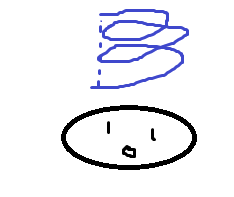Hi! Today we’re going to use some stuff we learned about a long time ago (non-Euclidean geometry, manifolds, and groups) and put it together to explore a particular group. This is based on a talk given by my dear friend and co-organizer Michelle Chu. “Co-organizer? Of what?” you ask. Well thanks for asking! Last weekend we did held the first Texas Women in Mathematics Symposium – we had over 60 people come, lots of talks, lots of networking, and lots of food. By the end of the day I got to add “annual” to that description, and it seems like a lot of schools were interested in hosting it in future years. Maybe some time I’ll write a post about how to found an annual conference (this is my second!).
Anyways, let’s first talk about tilings by triangles. We first choose some integers p, q, r and set the three angles of a base triangle equal to . Now reflect over each of the three sides to start tiling your space. Turns out this tiling will lead to a group. Here’s an example with p=q=4 and r=2 (so we have a right isosceles triangle):

Start with the pink triangle, and reflect it over each of the three sides to make the colored triangles as shown.

Now do the reflections again. I kept the pink base triangle and grayed out the first images. Note that I colored the bottom left image yellow, for reflecting over the vertical side of the bottom orange triangle, but I also could color it orange, for reflecting over the horizontal side of the left yellow triangle. This means that yellow+orange = orange+yellow in the group.

A third iteration of the same process; there are more relations here (that I didn’t color)
I picked a particularly good example, so that my triangles could tile the Euclidean plain. We learned some time ago about non-Euclidean geometries: the space is spherical if the sum of triangle angles is more than , and hyperbolic if triangles are thin and their sum of angles is less than
. So based on how I choose my p, q, and r, I’ll find myself tiling different spaces. Here’s an example of one iteration on a sphere for p=q=2 and r=5:
It’s pretty easy to find the integer solutions for p, q, r to tile each space. The only triangles that tile the flat plane are when (p,q,r) = (2,3,6), (2,4,4), and (3,3,3). We already saw (2,4,4), and I’ll just tell you that (3,3,3) is when you use equilateral triangles (so there are 6 around each vertex), and (2,3,6) are those 30-60-90 triangles we learned about back in trigonometry class: here’s the picture from wikipedia:

By R. A. Nonenmacher via wikipedia
Similarly there are only a few (relatively) that tile the sphere: (2,3,3), (2,3,4), (2,3,5), and (2,2, n), where n is some number bigger than 1. Of course this forms an infinite family of tilings, since you can choose n. In the example above I chose n=5, and if n is bigger the base pink triangle just gets skinnier.
But I say there’s only a few that tile the sphere because everything else tiles the hyperbolic plane. That’s a lot of choices! It might also make you think, “hm, maybe the hyperbolic plane is interesting.”
Let’s bring us back to groups. How does a tiling of a space lead to a group? Well, let the reflections over the (extended) sides of the base triangle be the generators of our group. If I name these a, b, and c, I immediately get the relators . Next we have to figure out the rest of the relators. I hinted at them in the pictures above. They are
. Now we have a group presentation [link for definition]
.
Also, fun coincidence: if you create the dual tree to the tiling by putting a vertex inside each triangle and connecting two vertices by a line if one triangle is the image of another under one of the reflections, you get something that looks a lot like the Cayley graph of the reflection triangle group. The only difference is that each edge needs to be two edges (like a little loop) to reflect that each generator has order 2.
So what’s special about the (2,3,7) triangle group? We know from above that it tiles the hyperbolic plane. Check out this great picture from wikipedia of the tiling:

Maybe we’ll take a second here to point out that you can see the p, q, r values in the tilings, both in this picture and the other wikipedia picture above for (2,3,6): pick your favorite triangle, and look at its three vertices. Each vertex is adjacent to n other triangles, and since there are angle around any vertex, we can figure out that p,q,r are just
.
Also, of all the integers you can pick for p, q, r, it turns out that 2, 3, and 7 maximize the sum while staying less than
. [It ends up giving you
for those of you keeping track at home.]
So we maximize something with the numbers 2, 3, 7. Well it turns out we do more than that- we also minimize the volume of the resulting quotient-we touched on and defined those in this post about manifolds. And this is unique (up to conjugation/fiddling), and makes the smallest possible quotient. Huzzah!
On a personal note, I’ve had a demonic cold keeping me in bed for the past two weeks, so forgive me if I messed up (pretty sure I did on the reflections; I’ll try to fix those soon). Also, hope you voted today! I voted a week and a half ago.










